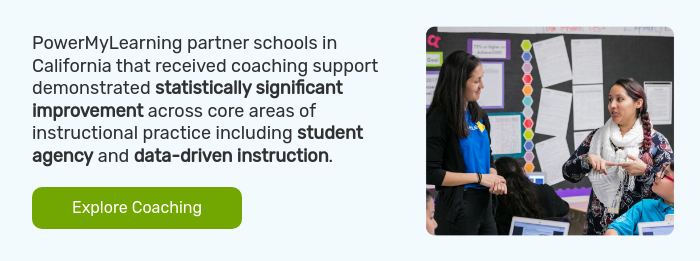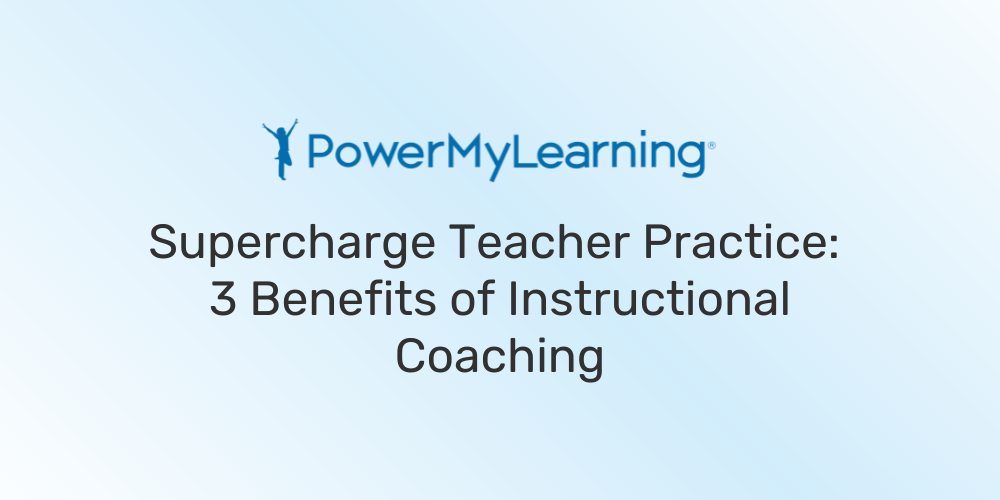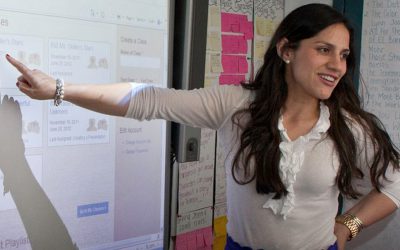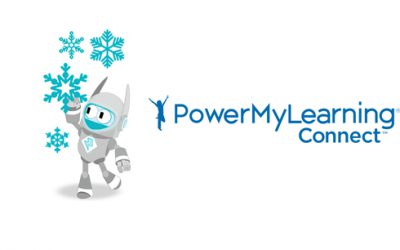Powerful Practice: Building Confidence through Productive Struggle with Instructional Coach Ty Armstrong
In this installment of our #PowerfulPractice series, we sat down with Ty Armstrong, one of PowerMyLearning’s star coaches. Since last school year, Ty has been making waves at a partner elementary school in Los Angeles, CA.
Partnership Kick-Off
At the beginning of this partnership, Ty worked with school leadership to learn about the school’s instructional initiatives and collaborate on how PowerMyLearning’s professional development could support third-grade teachers with reaching their goals for the year.
Ty was asked to support the third grade team with implementing the pilot of a new ELA program. She was tasked with creating an implementation plan that included a scope and sequence, demonstration lessons to model highly effective instructional strategies, and observations and debrief cycles.
One of the goals of this partnership was to ensure the third-grade team was providing rigorous instruction aligned to grade-level standards. Focus areas included student-led conversations and adding rigor to the writing, which aligned with PowerMyLearning’s Framework for Teachers.
Ty was also excited to be a part of the school’s vertical alignment strategy, where similar skills were reinforced across grade levels and classes.
The Power of Instructional Coaching
Research shows coaching is a top lever for strengthening teacher practice. A common value proposition that PowerMyLearning hears from partners nationwide is that our coaches help change teachers’ mindsets by building trusting relationships.
Coaches like Ty roll up their sleeves to model lessons so teachers feel safe to take risks. Partner teachers go from “my kids can’t” or “my kids won’t” to seeing firsthand that their students can and will.
In an end-of-year survey, 100% of third-grade teachers at the school who received coaching said they felt supported and implemented practices that strengthened their practice.
Leadership observed a noticeable difference in teachers’ mindsets and teachers reported feeling less overwhelmed.
Keep reading to learn more about how Ty’s collaboration with leadership, flexibility, and creative ideas led to a successful partnership that the school is now expanding.
PowerMyLearning: Can you share any advice or tips that laid the foundation for this successful partnership?
Ty: At the beginning of the partnership, I teamed up with school leadership to get clear on goals, set expectations, and discuss options for what implementation would look like. I received the following tips to help earn teachers’ trust:
- Follow through. Like most educators, my partner teachers appreciate follow-through. As a coach, if you say you’re going to do something, follow through and stay true to your word. This is core to building trust, and especially working with veteran teachers, I needed to prove my value before they could trust me.
- Make strategies actionable. It was very important to make sure that teachers could see lessons and strategies in action. I couldn’t just say a lesson was standards-based or model a strategy, I needed to point out what the standards were in every single lesson and spend time thinking through what implementation could look like. I frequently checked in on teachers’ capacity levels and talked through how to modify strategies to meet students where they were. One of our big goals for the year was around rigor, and so we needed to make sure students were ready to receive the content before delivery.
- Foster collaboration. This year, I provided teachers direct support with their lessons. Next year, teachers are going to be working closer with their peers to make sure what we built and wrote down in the scope and sequence continues to work.
PowerMyLearning: Can you describe what the beginning of this partnership looked like? What did you start with and how did you build trust with partner teachers?
Ty: At PowerMyLearning, we use a R.I.G.O.R. acronym to align on a shared definition before diving into the work. Academic rigor has to do with the complexity of the content, cognitive engagement, and the scope of the learning activity (Hess, et al., 2009).
Oftentimes, academic rigor can be confused with asking students to do more work. One of the first steps I took was to lead demo lessons based on the California Content Standards to make the program lessons shorter because they were too long for teachers to do five days a week.
Initially, teachers were not very receptive to me, especially the more veteran teachers. I personally love working with veteran teachers and enjoy taking the time to truly earn their trust and get their buy-in.
When the lead teacher presented me with a challenge me of cutting a two-hour lesson from the curriculum into 45 minutes, I immediately thought, you're going to be my new best friend and I'm going to prove to you that it can be done.
We talked about how to target elements of the curriculum that were standards-aligned and to chunk them into a successful lesson for her third-grade students. While initially resistant, I convinced her that trying this out would ultimately build her capacity and make her job easier.
Once she saw that it could be done effectively, the trust was there—she was like, ‘Okay, I can see you know what you’re talking about.’ I needed to get her on board in trusting me in order for the other teachers to believe in this work too.
PowerMyLearning: Being flexible and having the confidence to cut lessons, especially ones that repeated or were not tied to assessments, were keys to Ty’s success.
Ty: Teachers learned that they didn’t have to teach in the exact order that the curriculum was laid out and they could move content around. This motivated them to try new things and helped with the collaboration process. Along the way, I provided standards-aligned supports, which created the foundation and helped alleviate stress.
In order to effectively scaffold the content for students, we needed to modify the delivery. If a lesson was two hours long and it was vocabulary heavy, I gave teachers options, such as of focusing on the academic vocabulary or the content students would be assessed on at the end of the lesson.
Teachers found reassurance in knowing they were not going to get in trouble for cutting something out. Often, educators feel like they need to go through the entire 25 or so lessons exactly as it is laid out in the unit plan. There were units where we focused on 10 key lessons so we could make time for deep student-led conversations and add rigor to what students were being asked to do. We focused on reinforcing skills that were repeated across lessons.
Spacing saves teachers time and students are able to retain information better from frequent, shorter sessions than from longer ones.
Research shows that students who space out their learning outperform students who try to learn in longer sessions, even if spacing results in less total time on task.
In one class, we played ‘Headbands’ and turned it into an academic vocabulary game. At first, teachers did not think their kids would be into it. I convinced one teacher to try it and see what happened. I said if it doesn't work, we can go back to teaching academic vocabulary your way.
I took sentence strip papers, printed the vocabulary words in black and white, and stuck them on the headbands. Students then described the word on the headband to their classmate who was wearing it without saying what it was. They loved it!
We started to see students build autonomy as they learned and demonstrated learning. After, the teacher said they wanted to do it again and actually convinced the other teachers to try it too.
PowerMyLearning: What did the collaboration process look like across the grade?
Ty: Every other week, I led meetings for teachers’ Professional Learning Community (PLC) time. I was there two days a week so we would reflect on what happened while I was observing their lessons, recap what happened the other three days I was not on campus, and go from there. During our time together, we’d track progress and hold one another accountable to trying on new strategies in lessons we unpacked.
For example, I would check in with teachers to see if they were able to lead a small group discussion or lean into an academic vocabulary lesson. If they weren’t able to get something that week, we would make a plan together to ensure they got to it the following week. We made sure we were checking all the boxes.
Sometimes I would suggest cutting an entire unit if the content was not tied to their grade-level standards and teachers would look at me in disbelief. When students were preparing for state testing, I thought it would be fun to turn the lesson into project-based learning.
For one unit, I proposed using a Viking app, that had students pretend to be explorers. The teachers were skeptical at first, but one of the teachers came to me at the end and said her students loved the lesson! You know, you can't do your happy dance, but in my mind I was like "Yes!"
Again, this goes back to trust because initially she was not sure, but she had trust in me to try it and knew that I would be there alongside her for support and feedback. Knowing that I was open to feedback and able to change in the moment let them know that they’re able to change in the moment also.
PowerMyLearning: You’ve talked a lot about teacher capacity. It sounds like they saw more time freed up through your guidance in cutting things to drill deeper into other content. Did you have any observations about the student’s gains?
Ty: We worked very intentionally to build a culture that nurtured a growth mindset, where students felt safe enough to take academic risks.
One teacher wrote in her end-of-year survey that she saw her class grow more confident as the year progressed. In the beginning of the year, students wouldn't volunteer to read or raise their hand to answer questions.
We re-framed how we asked questions to build student's confidence and encourage them reflect on their learning. For example, some common questions we would ask were:
- “Who is willing to take a risk, even if you’re not sure that your answer is correct?”
- “Who wants to be brave and share their answer?”
- “Why is that?”
We explored different ways for students to demonstrate what they were learning and saw an uptick in engagement as students built confidence.
Soon enough, students were actually gesturing with their hands, “bring it, bring it,” when asked a challenging question.
These little shifts had big impact on engagement. In one class, I saw 100% of students’ hands go in the air instead of the same two or three. I could tell that they were more engaged in the lessons and asking questions.
PowerMyLearning: How did you ensure implementation was effective and measure success for leadership?
Ty: I made sure the support I was providing was actionable. When I went into classrooms, I’d collaborate with teachers on how to incorporate a specific strategy into their classroom and then evaluate it over the course of our time together.
Across all our partnerships, principals appreciate that their goals and priorities are in alignment with the work we do as PowerMyLearning coaches and our PowerMyLearning Framework for Teaching.
And if the alignment is not clear, I figure out how to make connections because I don't want to observe and provide feedback to teachers about one thing and then the principal observes and provides feedback to teachers on something totally different. The alignment in our work is key.
PowerMyLearning: What do you think was the outcome the principal was most happy with?
Ty: The school’s principal observed a clear difference in teachers’ mindsets from the beginning of the year, to the end. There was also a visible transformation in learning environments, with vocabulary posted on teachers’ bulletin boards and teachers leading small groups with their students and nurturing rich discussions.
School leadership also learned to manage their own expectations when walking into a classroom to observe. Change takes time and lessons do not always go exactly as planned. So, instead of asking teachers, "Why are you still on this lesson?" they now ask, "How can I support you?"
This might seem like a small nuance, but this shift in language reflected a larger cultural shift. As a leader, you’re not asking “What’s missing?” or “Why did this happen?” but instead reframing how you’re engaging with your teachers in a way that shows mutual respect.
Taking on an asset-based approach was a natural but unintended byproduct of this work.
PowerMyLearning: Was there anything that surprised you during this program implementation?
Ty: When the principal first told me to create a scope and sequence and get veteran teachers to buy in, I thought, “What did I get myself into?” The ‘a-ha’ moment for me was being able to pull it off, taking what was 11 units for a 10-month school year and making it work. I told myself, “You’ve been telling the kids to accept these challenges and take risks and that they can do it so you can do it too.”
At the end, I wasn't sure how the teachers were going to feel about the survey, but I got 100% of them to respond.
There was one teacher who wrote in her notes that she was never comfortable with people coming into her classroom to observe because she felt like she was being judged. She said I helped build her confidence and supported her as a teammate with teaching the new curriculum, unpacking lessons, and sticking to standards.
This melted my heart that she actually named that, because it's hard when you have people coming in and giving feedback.
We all found strength in productive struggle.



